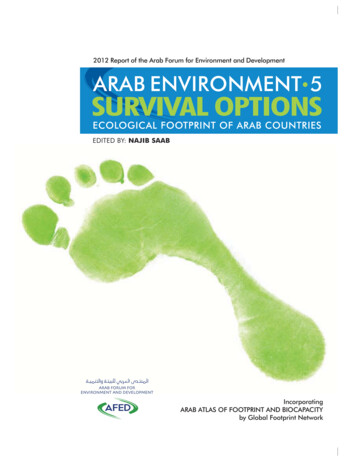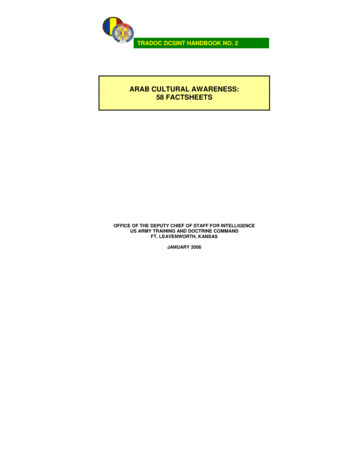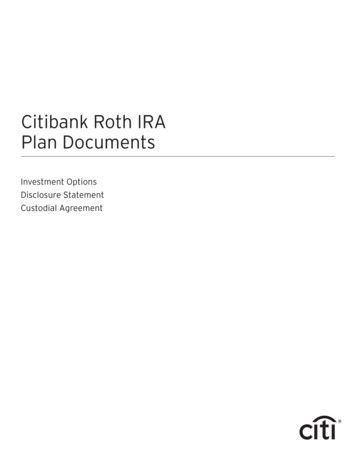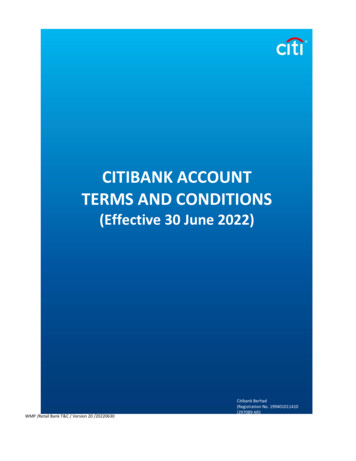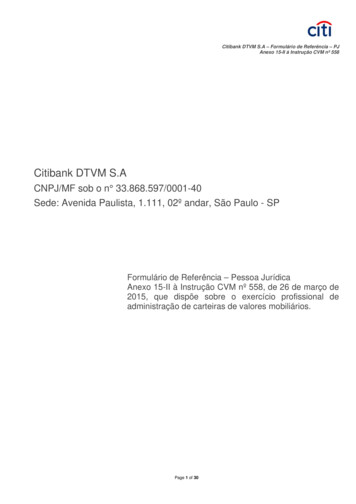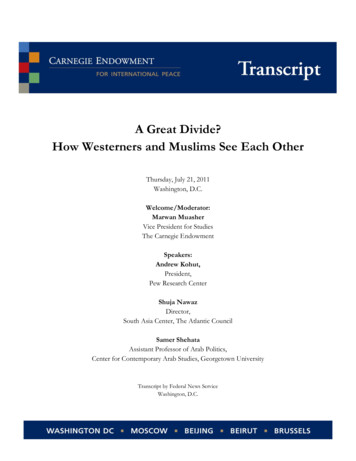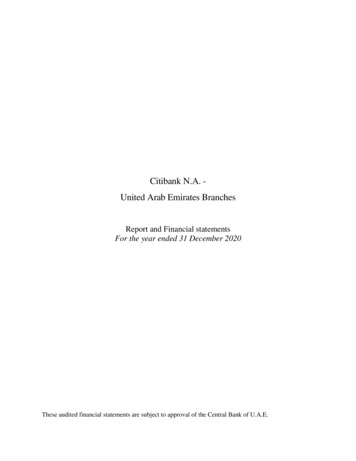
Transcription
Citibank N.A. United Arab Emirates BranchesReport and Financial statementsFor the year ended 31 December 2020These audited financial statements are subject to approval of the Central Bank of U.A.E.
Citibank N.A. - United Arab Emirates BranchesFinancial statements31 December 2020ContentsPageIndependent auditors’ report1-3Statement of financial position4Statement of profit or loss5Statement of comprehensive income6Statement of changes in equity7Statement of cash flows8Notes to the financial statements9 – 73
Deloitte & Touche (M.E.)Building 3, Level 6Emaar SquareDowntown DubaiP.O. Box 4254DubaiUnited Arab EmiratesTel: 971 (0) 4 376 8888Fax: 971 (0) 4 376 8899www.deloitte.comAugust 17th, 2016INDEPENDENT AUDITOR’S REPORTTo the Head Office ofCitibank N.A. United Arab Emirates BranchesUnited Arab EmiratesReport on the audit of the financial statementsOpinionWe have audited the financial statements of Citibank N.A. – United Arab Emirates Branches (the“Bank”), which comprise the statement of financial position as at 31 December 2020, and the statement ofprofit or loss, statement of comprehensive income, statement of changes in equity and statement of cashflows for the year then ended, and notes to the financial statements, including a summary of significantaccounting policies.In our opinion, the accompanying financial statements present fairly, in all material respects, the financialposition of the Bank as at 31 December 2020 and its financial performance and its cash flow for the yearthen ended in accordance with International Financial Reporting Standards (“IFRS”).Basis for opinionWe conducted our audit in accordance with International Standards on Auditing (“ISAs”). Ourresponsibilities under those standards are further described in the Auditor’s responsibilities for the audit ofthe financial statements section of our report. We are independent of the Bank in accordance with theInternational Ethics Standards Board for Accountants’ Code of Ethics for Professional Accountants (the“IESBA Code”) together with the ethical requirements that are relevant to our audit of the financialstatements in the United Arab Emirates, and we have fulfilled our other ethical responsibilities inaccordance with these requirements and the IESBA Code. We believe that the audit evidence we haveobtained is sufficient and appropriate to provide a basis for our opinion.Responsibilities of management and those charged with governance for the financial statementsManagement is responsible for the preparation and fair presentation of the financial statements inaccordance with IFRS and in compliance with the applicable provisions of the UAE Federal Law No (2) of2015, and for such internal control as management determines is necessary to enable the preparation offinancial statements that are free from material misstatement, whether due to fraud or error.In preparing the financial statements, management is responsible for assessing the Banks’ ability to continueas a going concern, disclosing, as applicable, matters related to going concern and using the going concernbasis of accounting unless management either intends to liquidate the Bank or to cease operations, or hasno realistic alternative but to do so.Those charged with governance are responsible for overseeing the Bank’ financial reporting process.Cont’d Akbar Ahmad (1141), Cynthia Corby (995), Georges Najem (809), Mohammad Jallad (1164), Mohammad Khamees Al Tah (717),Musa Ramahi (872), Mutasem M. Dajani (726), Obada Alkowatly (1056), Rama Padmanabha Acharya (701) and Samir Madbak (386)are registered practicing auditors with the UAE Ministry of Economy.
Independent Auditor’s Report to the Head Office ofCitibank N.A. United Arab Emirates Branches (continued)Auditor’s responsibilities for the audit of the financial statementsOur objectives are to obtain reasonable assurance about whether the financial statements as a whole are freefrom material misstatement, whether due to fraud or error, and to issue an auditor’s report that includes ouropinion. Reasonable assurance is a high level of assurance, but is not a guarantee that an audit conductedin accordance with ISAs will always detect a material misstatement when it exists. Misstatements can arisefrom fraud or error and are considered material if, individually or in the aggregate, they could reasonablybe expected to influence the economic decisions of users taken on the basis of these financial statements.As part of an audit in accordance with ISAs, we exercise professional judgment and maintain professionalskepticism throughout the audit. We also: Identify and assess the risks of material misstatement of the financial statements, whether due to fraudor error, design and perform audit procedures responsive to those risks, and obtain audit evidence thatis sufficient and appropriate to provide a basis for our opinion. The risk of not detecting a materialmisstatement resulting from fraud is higher than for one resulting from error, as fraud may involvecollusion, forgery, intentional omissions, misrepresentations, or the override of internal control. Obtain an understanding of internal control relevant to the audit in order to design audit proceduresthat are appropriate in the circumstances, but not for the purpose of expressing an opinion on theeffectiveness of the Banks’ internal control. Evaluate the appropriateness of accounting policies used and the reasonableness of accountingestimates and related disclosures made by management. Conclude on the appropriateness of management’s use of the going concern basis of accounting and,based on the audit evidence obtained, whether a material uncertainty exists related to events orconditions that may cast significant doubt on the Banks ability to continue as a going concern. If weconclude that a material uncertainty exists, we are required to draw attention in our auditor’s reportto the related disclosures in the financial statements or, if such disclosures are inadequate, to modifyour opinion. Our conclusions are based on the audit evidence obtained up to the date of our auditor’sreport. However, future events or conditions may cause the Bank to cease to continue as a goingconcern. Evaluate the overall presentation, structure and content of the financial statements, including thedisclosures, and whether the financial statements represent the underlying transactions and events ina manner that achieves fair presentation.We communicate with the management regarding, among other matters, the planned scope and timing ofthe audit and significant audit findings, including any significant deficiencies in internal control that weidentify during our audit.2
Independent Auditor’s Report to the Head Office ofCitibank N.A. United Arab Emirates Branches (continued)Report on Other Legal and Regulatory RequirementsAs required by the UAE Federal Law No. (2) of 2015, we report that for the year ended 31 December 2020: we have obtained all the information we considered necessary for the purposes of our audit; the financial statements have been prepared and comply, in all material respects, with the applicableprovisions of the UAE Federal Law No. (2) of 2015; the Bank has maintained proper books of account; investments during the year ended 31 December 2020, are disclosed in note 9 to the financialstatements; note 23 reflects material related party transactions and the terms under which they were conducted; based on the information that has been made available to us, nothing has come to our attention whichcauses us to believe that the Bank has contravened during the financial year ended 31 December 2020any of the applicable provisions of the UAE Federal Law No. (2) of 2015 of Articles of Associationwhich would have a material impact on its activities or its financial position as at 31 December 2020;and note 18 reflects the social contributions made during the year ended 31 December 2020.Further, as required by the Article 114 of the Decretal Federal Law No. (14) of 2018, we report that wehave obtained all the information and explanations we considered necessary for the purpose of our audit.Deloitte & Touche (M.E.)Musa RamahiRegistration No: 87231 March 2021DubaiUnited Arab Emirates3
31 March 2021
Citibank N.A. - United Arab Emirates BranchesStatement of profit or lossfor the year ended 31 December 2020Interest incomeInterest 8631,693,6002,108,917Net interest incomeIncome from Islamic financing27Net interest and Islamic financing incomeFees and commission income – netOther operating income – netNet gain on investments1726Total incomeGeneral and administrative expensesImpairment losses1828Profit for the year before taxationTaxation19Profit for the yearThe accompanying notes form an integral part of these financial statements.The independent auditors’ report is set out on page 2,771(96,584)(183,882)382,101718,889
Citibank N.A. - United Arab Emirates BranchesStatement of comprehensive incomefor the year ended 31 December 2020Profit for the year2020AED'0002019AED'000382,101718,889Other comprehensive income:Items that will never be reclassified to profit or lossRe-measurement of post-employment benefitsNet charge from Citigroup Inc. - share based incentivesItems that are or may be reclassified to profit or lossChange in fair value of investments classified as fair value through othercomprehensive incomeNet amount transferred to profit and loss on investments classified asfair value through comprehensive incomeOther comprehensive (loss)/income for the yearTotal comprehensive income for the yearThe accompanying notes form an integral part of these financial statements.The independent auditors’ report is set out on page 8,454731,692
Citibank N.A. - United Arab Emirates BranchesStatement of changes in equityfor the year ended 31 December At 1 January 2019Total comprehensiveincomeProfit for the yearOther comprehensiveincome, net of taxShare based paymenttransactionsMeasurement of postemployment benefitsRepatriation of funds tohead office135,90167,951---Fair ,360)---1,490-1,490----At 31 December 2019135,90167,9514,2126,7502,904,8833,119,697At 1 January 2020Total comprehensiveincomeProfit for the yearOther comprehensiveincome, net of taxShare based paymenttransactionsMeasurement of postemployment benefitsRepatriation of funds tohead 54)(718,889)(668,454)(718,889)-At 31 December 2020135,90167,951The accompanying notes form an integral part of these financial statements.The independent auditors’ report is set out on page 1-3.72,568,0952,779,262
Citibank N.A. - United Arab Emirates BranchesStatement of cash flowsfor the year ended 31 December 48)(13,863)13,132577,532879,977Decrease in reserve with the Central Bank of UAEDecrease in due from BanksDecrease/(increase) in loans and advances to customersDecrease/(increase) in other assets excluding taxationIncrease in customer deposits(Decrease)/increase in other liabilities excluding taxationTaxes paidEnd of service benefit ,09091,802(163,781)(4,492)Net cash flows generated from operating activities7,428,124Cash flow from investing activitiesPurchase of property and equipment- netProceeds from disposal of property and equipmentPurchase of investmentsProceeds from sale of 679)Cash flow from financing activitiesRepatriation of profits to Head office(718,889)(668,454)Net cash flows used in investing activities(718,889)(668,454)Cash flow from operating activitiesProfit for the year before taxAdjustment for non-cash items:DepreciationLoss on sale of property and equipmentNet charge on financial assetsDerivativesNet gain on investmentsEnd of service benefitOperating cash before changes in operating assets and liabilitiesNet cash flows used in investing activities1,384,095Increase / (decrease) in cash and cash equivalents1,383,038(1,718,038)Cash and cash equivalents at the beginning of the year3,260,8634,978,901Cash and cash equivalents at the end of the year (Note 21)4,643,9013,260,863The accompanying notes form an integral part of these financial statements.The independent auditors’ report is set out on page 1-3.8
Citibank N.A. - United Arab Emirates BranchesNotes to the financial statementsfor the year ended 31 December 20201.Legal status and principal activitiesCitibank N.A. – United Arab Emirates Branches (“the Bank”) operates in the United Arab Emirates(“UAE”) through its four branches (2019: four) located in the Emirates of Abu Dhabi, Dubai and Sharjahunder a license issued by the Central Bank of UAE (“CBUAE”).The principal activities of the Bank include accepting deposits, granting loans and advances and providingconsumer and corporate banking, including treasury activities.The registered office and the address of the Bank is P.O. Box 749, Dubai, UAE.The Bank is a branch of Citibank N.A. USA. The ultimate holding company of the Bank is Citigroup Inc.These financials reflect the activities of the Branches in the United Arab Emirates only and exclude alltransactions, assets and liabilities of the head office and its other branches elsewhere. Since the capital ofthe Bank is not publicly traded, no segment analysis has been prepared.2.Basis of preparationa)Statement of complianceThese financial statements have been prepared in accordance with International Financial Reportingstandards (“IFRS”) as issued by International Accounting Standard Board (“IASB”), and the applicablerequirements of the UAE Federal law No. 2 of 2015.Federal Decree-Law No. 26 of 2020 which amends certain provision of Federal Law No. 2 of 2015 oncommercial Companies was issued on 27 September 2020 and the amendments came into effect on 2January 2021. The Branches are in the process of reviewing the new provisions and will apply therequirements thereof no later than one year from the date on which the amendments came into effect.b)Basis of measurementThe financial statements have been prepared on the historical cost basis except for the following: derivative financial instruments are measured at fair value;financial instruments at fair value through profit or loss are measured at fair value;financial instruments at fair value through other comprehensive income are measured at fair value;the liability for defined benefit obligations is recognized as the present value of the defined benefitobligation less the net total of the plan assets, plus unrecognized actuarial gains, less unrecognizedpast service cost and unrecognized actuarial losses; andliabilities for cash settled share-based payment arrangements are measured at fair value.c)Functional and presentation currencyThe financial statements are presented in Arab Emirates Dirhams (“AED”), which is the Bank’s functionalcurrency, rounded to the nearest thousand except when otherwise indicated.9
Citibank N.A. - United Arab Emirates BranchesNotes to the financial statementsfor the year ended 31 December 20202.Basis of preparation (continued)d)Use of estimates and judgmentsThe preparation of financial statements in conformity with IFRS requires management to make judgements,estimates and assumptions that affect the application of policies and reported amounts of assets andliabilities and disclosures of contingent assets and liabilities at the date of the financial statements and thereported amounts of revenues and expenses during the reported period. The estimates and assumptions arebased on management's best knowledge of current events, actions, historical experience and various otherfactors that are believed to be reasonable under the circumstances, the results of which form the basis ofmaking the judgements about the carrying values of assets and liabilities that are not readily apparent fromother sources. Actual results may differ from these estimates.The estimates and underlying assumptions are reviewed on an ongoing basis. Revisions to accountingestimates are recognised in the period in which the estimate is revised if the revision affects only that periodor in the period of the revision and future periods if the revision affects both current and future periods.Information about significant areas of estimation uncertainties and critical judgements in applyingaccounting policies that have the most significant effect on the amounts recognised in the financialstatements are described in note 3.e)New and revised IFRSs applied on the consolidated financial statementsThe following new and revised IFRSs, which became effective for annual periods beginning on or after1 January 2020, have been adopted in these consolidated financial statements.In the current year, the Group has applied a number of amendments to IFRS Standards and Interpretationsissued by the International Accounting Standards Board (IASB) that are effective for an annual period thatbegins on or after 1 January 2020.Their adoption has not had any material impact on the disclosures or on the amounts reported in thesefinancial statements.New and revised IFRSSummaryAmendments to IFRS 9 FinancialInstruments, IAS 39 Financial Instruments:Recognition and Measurement and IFRS 7Financial Instruments Disclosures relating tointerest rate benchmark reformThe changes modify specific hedge accounting requirements so thatentities would apply those hedge accounting requirementsassuming that the interest rate benchmark on which thehedged cash flows and cash flows from the hedginginstrument are based will not be altered as a result ofinterest rate benchmark reform; are mandatory for all hedging relationships that aredirectly affected by the interest rate benchmark reform; are not intended to provide relief from any otherconsequences arising from interest rate benchmark reform(if a hedging relationship no longer meets the requirementsfor hedge accounting for reasons other than those specifiedby the amendments, discontinuation of hedge accountingis required); and require specific disclosures about the extent to which theentities' hedging relationships are affected by theamendments.10
Citibank N.A. - United Arab Emirates BranchesNotes to the financial statementsfor the year ended 31 December 20202.Basis of preparation (continued)e)New and revised IFRSs applied on the consolidated financial statements (continued)New and revised IFRSSummaryAmendment to IFRS 3 Business The amendments in Definition of a Business (Amendments toCombinations relating to definition of a IFRS 3) are changes to Appendix A Defined terms, theapplication guidance, and the illustrative examples of IFRS 3businessonly. They: clarify that to be considered a business, an acquired set ofactivities and assets must include, at a minimum, an inputand a substantive process that together significantlycontribute to the ability to create outputs; narrow the definitions of a business and of outputs byfocusing on goods and services provided to customers andby removing the reference to an ability to reduce costs; add guidance and illustrative examples to help entitiesassess whether a substantive process has been acquired; remove the assessment of whether market participants arecapable of replacing any missing inputs or processes andcontinuing to produce outputs; and add an optional concentration test that permits a simplifiedassessment of whether an acquired set of activities andassets is not a business.Amendments to References to the The Group has adopted the amendments to IFRS 2, IFRS 6,ConceptualFrameworkinIFRS IFRS 15, IAS 1, IAS 8, IAS 34, IAS 37, IAS 38, IFRIC 12,Standards - amendments to IFRS 2 Share- IFRIC 19, IFRIC 20, IFRIC 22, and SIC 21 in the current year.based payment, IFRS 3 BusinessCombinations, IFRS 6 Exploration forand Evaluation of Mineral Resources,IFRS 14 Regulatory Deferral Accounts,IAS 1 Presentation of FinancialStatements, IAS 8 Accounting Policies,Changes in Accounting Estimates andErrors, IAS 34 Interim FinancialReporting, IAS 37 Provisions, ContingentLiabilities and Contingent Assets, IAS 38Intangible Assets, IFRIC 12 ServiceConcession Arrangements, IFRIC 19Extinguishing of Financial Liabilitieswith Equity Instruments, IFRIC 20Stripping Costs in the Production Phaseof a Surface Mine, IFRIC 22 ForeignCurrency Transactions and AdvanceConsideration, and SIC-32 IntangibleAssets – Web Site Costs to update thosepronouncements with regard to referencesto and quotes from the framework or toindicate where they refer to a differentversion of the Conceptual Framework.11
Citibank N.A. - United Arab Emirates BranchesNotes to the financial statementsfor the year ended 31 December 20202.Bas--is of preparation (continued)e)New and revised IFRSs applied on the consolidated financial statements (continued)New and revised IFRSSummaryAmendments to IAS 1 Presentation ofFinancial Statements and IAS 8Accounting Policies, Changes inAccounting Estimates and Errorsrelating to definition of materialThree new aspects of the new definition should especially benoted: Obscuring. The existing definition only focused onomitting or misstating information, however, the Boardconcluded that obscuring material information withinformation that can be omitted can have a similar effect.Although the term obscuring is new in the definition, it wasalready part of IAS 1 (IAS 1.30A). Could reasonably be expected to influence. The existingdefinition referred to 'could influence' which the Board feltmight be understood as requiring too much information asalmost anything ‘could’ influence the decisions of someusers even if the possibility is remote. Primary users. The existing definition referred only to'users' which again the Board feared might be understoodtoo broadly as requiring to consider all possible users offinancial statements when deciding what information todisclose.Amendments to IFRS 16 Leasesrelating to Covid-19-Related RentConcessionsThe amendment provides lessees with an exemption fromassessing whether a COVID-19-related rent concession is alease modification.Other than the above, there are no other significant IFRSs and amendments that were effective for the firsttime for the financial year beginning on or after 1 January 2020.f)New and revised IFRSs in issue but not yet effectiveEffective forannual periodsbeginning on or afterNew and revised IFRSsInterest Rate Benchmark Reform — Phase 2 (Amendments to IFRS 9Financial Instruments, IAS 39 Financial Instruments: Recognition andMeasurement, IFRS 7 Financial Instruments Disclosures, IFRS 4Insurance Contracts and IFRS 16 Leases)The amendments in Interest Rate Benchmark Reform — Phase 2(Amendments to IFRS 9, IAS 39, IFRS 7, IFRS 4 and IFRS 16) introducea practical expedient for modifications required by the reform, clarify thathedge accounting is not discontinued solely because of the IBOR reform,and introduce disclosures that allow users to understand the nature andextent of risks arising from the IBOR reform to which the entity is exposedto and how the entity manages those risks as well as the entity’s progressin transitioning from IBORs to alternative benchmark rates, and how theentity is managing this transition.121 January 2021
Citibank N.A. - United Arab Emirates BranchesNotes to the financial statementsfor the year ended 31 December 20202.Basis of preparation (continued)f)New and revised IFRSs in issue but not yet effective (continued)Effective forannual periodsbeginning on or afterNew and revised IFRSsAmendments to IFRS 3 Business Combinations relating to Reference tothe Conceptual FrameworkThe amendments update an outdated reference to the ConceptualFramework in IFRS 3 without significantly changing the requirements inthe standard.Amendments to IAS 16 Property, Plant and Equipment relating toProceeds before Intended UseThe amendments prohibit deducting from the cost of an item of property,plant and equipment any proceeds from selling items produced whilebringing that asset to the location and condition necessary for it to becapable of operating in the manner intended by management. Instead, anentity recognises the proceeds from selling such items, and the cost ofproducing those items, in profit or loss.1 January 2022Amendments to IAS 37 Provisions, Contingent Liabilities and ContingentAssets relating to Onerous Contracts - Cost of Fulfilling a ContractThe amendments specify that the ‘cost of fulfilling’ a contract comprisesthe ‘costs that relate directly to the contract’. Costs that relate directly to acontract can either be incremental costs of fulfilling that contract (exampleswould be direct labour, materials) or an allocation of other costs that relatedirectly to fulfilling contracts (an example would be the allocation of thedepreciation charge for an item of property, plant and equipment used infulfilling the contract).1 January 2022Annual Improvements to IFRS Standards 2018 – 2020Makes amendments to the following standards: IFRS 1 First-Time Adoption of International Financial ReportingStandards – The amendment permits a subsidiary that appliesparagraph D16(a) of IFRS 1 to measure cumulative translationdifferences using the amounts reported by its parent, based on theparent’s date of transition to IFRSs. IFRS 9 Financial Instruments – The amendment clarifies which feesan entity includes when it applies the ‘10 per cent’ test in paragraphB3.3.6 of IFRS 9 in assessing whether to derecognise a financialliability. An entity includes only fees paid or received between theentity (the borrower) and the lender, including fees paid or received byeither the entity or the lender on the other’s behalf. IFRS 16 Leases – The amendment to Illustrative Example 13accompanying IFRS 16 removes from the example the illustration ofthe reimbursement of leasehold improvements by the lessor in order toresolve any potential confusion regarding the treatment of leaseincentives that might arise because of how lease incentives areillustrated in that example.131 January 2022
Citibank N.A. - United Arab Emirates BranchesNotes to the financial statementsfor the year ended 31 December 20202.Basis of preparation (continued)f)New and revised IFRSs in issue but not yet effective (continued)Effective forannual periodsbeginning on or afterNew and revised IFRSsAnnual Improvements to IFRS Standards 2018 – 2020Makes amendments to the following standards: (continued) IAS 41 Agriculture – The amendment removes the requirement inparagraph 22 of IAS 41 for entities to exclude taxation cash flows whenmeasuring the fair value of a biological asset using a present valuetechnique.1 January 2022Amendments to IAS 1 Presentation of Financial Statements relating toClassification of Liabilities as Current or Non-CurrentThe amendments aim to promote consistency in applying the requirementsby helping companies determine whether, in the statement of financialposition, debt and other liabilities with an uncertain settlement date shouldbe classified as current (due or potentially due to be settled within one year)or non-current.Amendments to IFRS 4 Insurance Contracts Extension of the TemporaryExemption from Applying IFRS 9The amendment changes the fixed expiry date for the temporary exemptionin IFRS 4 from applying IFRS 9 Financial Instruments, so that entitieswould be required to apply IFRS 9 for annual periods beginning on or after1 January 2023.IFRS 17 Insurance ContractsIFRS 17 requires insurance liabilities to be measured at a currentfulfillment value and provides a more uniform measurement andpresentation approach for all insurance contracts. These requirements aredesigned to achieve the goal of a consistent, principle-based accounting forinsurance contracts. IFRS 17 supersedes IFRS 4 Insurance Contracts as of1 January 2023.Amendments to IFRS 17 Insurance ContractsAmends IFRS 17 to address concerns and implementation challenges thatwere identified after IFRS 17 Insurance Contracts was published in 2017.The main changes are: Deferral of the date of initial application of IFRS 17 by two years toannual periods beginning on or after 1 January 2023. Additional scope exclusion for credit card contracts and similarcontracts that provide insurance coverage as well as optional scopeexclusion for loan contracts that transfer significant insurance risk. Recognition of insurance acquisition cash flows relating to expectedcontract renewals, including transition provisions and guidance forinsurance acquisition cash flows recognised in a business acquired ina business combination.1 January 2023141 January 20231 January 20231 January 2023
Citibank N.A. - United Arab Emirates BranchesNotes to the financial statementsfor the year ended 31 December 20202.Basis of preparation (continued)f)New and revised IFRSs in issue but not yet effective (continued)Effective forannual periodsbeginning on or afterNew and revised IFRSsAmendments to IFRS 17 Insurance Contracts (continued) Clarification of the application of IFRS 17 in interim financialstatements allowing an accounting policy choice at a reporting entitylevel. Clarification of the application of contractual service margin (CSM)attributable to investment-return service and investment-relatedservice and changes to the corresponding disclosure re
5 Citibank N.A. - United Arab Emirates Branches Statement of profit or loss for the year ended 31 December 2020 2020 2019 Note AED'000 AED'000 Interest income 24 915,483 1,272,061 Interest expense 25 (54,905) (110,185) Net interest income 860,578 1,161,876 Income from Islamic financing 27 8,836 7,607 Net interest and Islamic financing income 869,414 1,169,483
